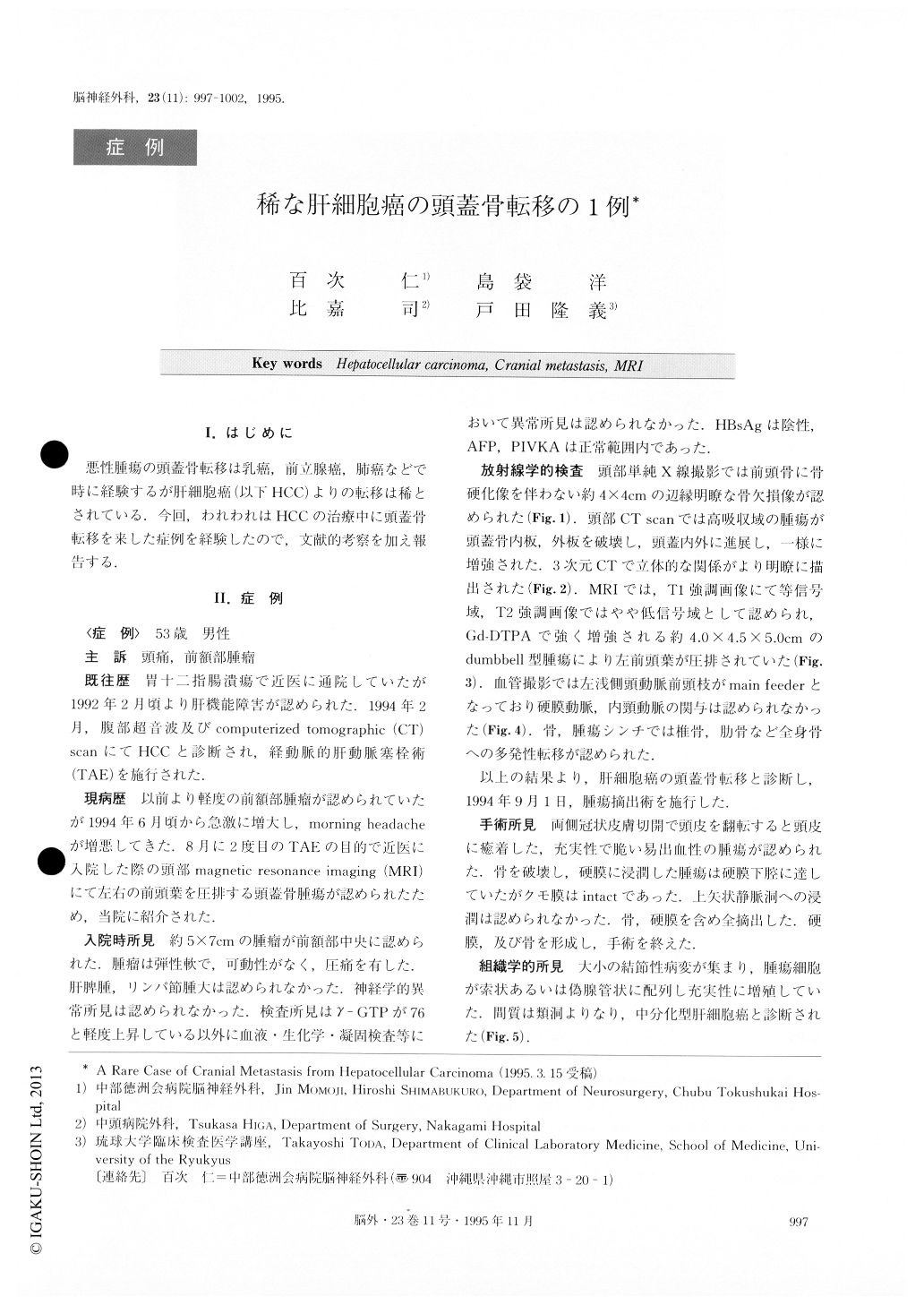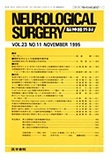Japanese
English
- 有料閲覧
- Abstract 文献概要
- 1ページ目 Look Inside
I.はじめに
悪性腫瘍の頭蓋骨転移は乳癌,前立腺癌,肺癌などで時に経験するが肝細胞癌(以下HCC)よりの転移は稀とされている.今回,われわれはHCCの治療中に頭蓋骨転移を来した症例を経験したので,文献的考察を加え報告する.
This is the first reported case of magnetic resonance imaging (MRI) findings of cranial metastasis from hepatocellular carcinoma. A 53-year-old male was admitted to our hospital on August 23, 1994, complain-ing of severe headache and a subcutaneous mass on the forehead. He was diagnosed as hepatocellular carcino-ma in February, 1994, at another hospital. Because of multiple intrahepatic metastasis, he was inoperable and received transarterial embolization (TAE) on February 15, 1994. He had noticed the subcutaneous mass two months prior to admission, and its recent rapid growth, and morning headache.
On admission, there was no abnormality observed by neurological and physical examination except the sub-cutaneous mass on his forehead, 5×7cm in size. It waselastic soft and unmovable, and he felt tenderness. Laboratory examination showed only mild liver dys-function. HBsAg was negative, and alpha-fetoprotein and PIVKA-Ⅱ (Protein Induced by Vitamin K Antagonists) were within normal limit. Skull X-ray showed a round bone defect in the frontal bone. Com-puterized tomographic (CT) scan showed bone destruc-tion and a well-circumscribed high density mass ex-tending from the frontal subcutaneous region into the cranial cavity. MRI showed the tumor compressing the left frontal lobe on T1 weighted image as isointense and T2 weighted image showed a slight low intense mass. The tumor was clearly enhanced on both CT scan and MRI. Left external carotid angiogram demon-strated that the hypervascular tumor mainly fed by a frontal branch of the left superficial temporal artery in the frontal region. Tumor and bone scintigram revealed multiple bone metastasis. Lung CT scan showed no metastasis. A total removal of the metastatic tumor of the forehead was carried out on September 1, 1994. The tumor was soft and hemorrhagic mass, extending into the subdural space, although arachnoid membrane was intact. Histological diagnosis was skull metastasis of hepatocellular carcinoma. Postoperative course was uneventful. He was discharged on foot on September 22, 1994.
The incidence of cranial metastasis of hepatocellular carcinoma is rare, approximately 0.88% of 43047 autop-sied cases of hepatocellular carcinoma. Based on our experience and reviews of literature (23 cases), we con-sidered the following aspects. 1) Cranial metastasis from hepatocellular carcinoma should be included as a differential diagnosis of solitary, osteolytic and hyper-vascular skull tumor. 2) It was so hemorrhagic that there was the possibility of sudden deterioration by in-tracranial hemorrhage. 3) Because of very poor prog-nosis, but taking into account the need to preserve quality of life, there is urgent reason for choosing surgery as the most suitable option.

Copyright © 1995, Igaku-Shoin Ltd. All rights reserved.


